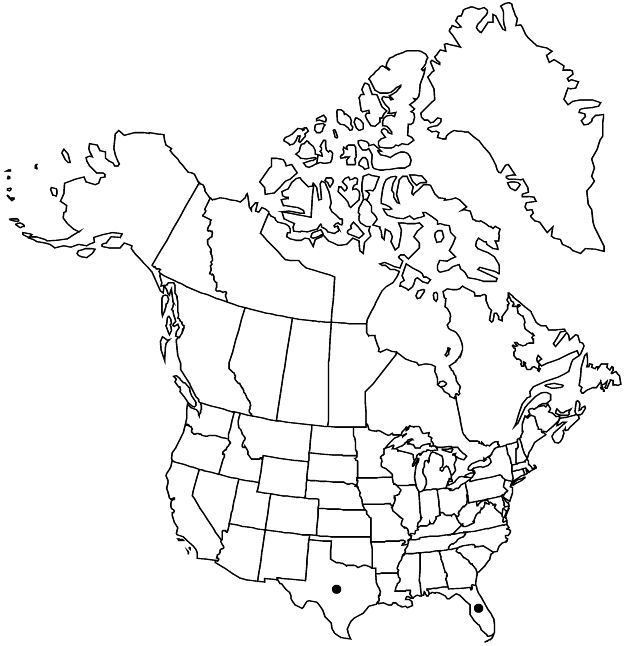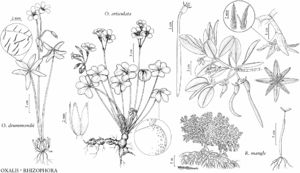Difference between revisions of "Rhizophora mangle"
Sp. Pl. 1: 443. 1753.
FNA>Volume Importer |
FNA>Volume Importer |
||
| Line 33: | Line 33: | ||
|habitat=Shallow, brackish to saline water in sand, silt, mud, or clay of coastal and estuarine sand flats and swamps. | |habitat=Shallow, brackish to saline water in sand, silt, mud, or clay of coastal and estuarine sand flats and swamps. | ||
|distribution=Fla.;Tex.;Mexico;West Indies;Central America;South America;Africa;Pacific Islands. | |distribution=Fla.;Tex.;Mexico;West Indies;Central America;South America;Africa;Pacific Islands. | ||
| − | |discussion=<p>Rhizophora mangle is native to the Americas and west Africa; it was introduced to Hawaii early in the 20th century for erosion control and has become invasive there. The species is particularly susceptible to freezing temperatures, which limit the northern (and southern) extent of its range. In Florida, it is found on the immediate Atlantic and Gulf seacoasts north to Saint Johns County at almost 30° north latitude (W. B. Zomlefer et al. 2006). K. C. Cavanaugh et al. (2014) determined that its abundance has increased significantly at the northern edge of the range, likely due to a decline in the frequency of severe cold events. Rhizophora mangle has recently become established along the Texas coast, presumably also as a result of a warming climate (P. A. Montagna et al. 2011).</p><!-- | + | |discussion=<p><i>Rhizophora mangle</i> is native to the Americas and west Africa; it was introduced to Hawaii early in the 20th century for erosion control and has become invasive there. The species is particularly susceptible to freezing temperatures, which limit the northern (and southern) extent of its range. In Florida, it is found on the immediate Atlantic and Gulf seacoasts north to Saint Johns County at almost 30° north latitude (W. B. Zomlefer et al. 2006). K. C. Cavanaugh et al. (2014) determined that its abundance has increased significantly at the northern edge of the range, likely due to a decline in the frequency of severe cold events. <i>Rhizophora mangle</i> has recently become established along the Texas coast, presumably also as a result of a warming climate (P. A. Montagna et al. 2011).</p><!-- |
--><p>Seedling propagules may float in the ocean and remain viable for up to a year before reaching a suitable substrate where they resume growth. Propagules occasionally wash ashore and become temporarily established north of its range (to North Carolina), but plants do not currently survive long-term (A. S. Weakley 2012). Records from the Florida panhandle are also assumed to be temporarily established plants (B. Hansen, pers. comm.).</p> | --><p>Seedling propagules may float in the ocean and remain viable for up to a year before reaching a suitable substrate where they resume growth. Propagules occasionally wash ashore and become temporarily established north of its range (to North Carolina), but plants do not currently survive long-term (A. S. Weakley 2012). Records from the Florida panhandle are also assumed to be temporarily established plants (B. Hansen, pers. comm.).</p> | ||
|tables= | |tables= | ||
| Line 57: | Line 57: | ||
|publication year=1753 | |publication year=1753 | ||
|special status=Weedy;Selected by author to be illustrated | |special status=Weedy;Selected by author to be illustrated | ||
| − | |source xml=https://jpend@bitbucket.org/aafc-mbb/fna-data-curation.git/src/ | + | |source xml=https://jpend@bitbucket.org/aafc-mbb/fna-data-curation.git/src/8f726806613d60c220dc4493de13607dd3150896/coarse_grained_fna_xml/V12/V12_144.xml |
|genus=Rhizophora | |genus=Rhizophora | ||
|species=Rhizophora mangle | |species=Rhizophora mangle | ||
Revision as of 14:43, 18 September 2019
Shrubs or trees, 6–7[–25] m. Prop roots numerous, arching, 2–4.5 m. Leaves: stipules lanceolate, leaving ring-shaped scar; petioles 1.5–2 cm; blade elliptic, 6–12 × 2.2–6 cm, thick, leathery, base rounded-cuneate, apex acute to obtuse, midvein extended into caducous point, abaxial surface pale green, black punctate, adaxial surface dark green, shiny; midvein conspicuous, higher order veins obscure. Inflorescences mostly 2–4-flowered, 4–7 cm. Flowers 2 cm diam.; hypanthium campanulate-funnelform, 5 mm; sepals widely spreading, pale yellow, lanceolate or narrowly triangular, 12 mm, leathery; petals recurved, creamy white, turning brown in age, narrowly lanceolate to linear, 6–10 × 1.5–2 mm, adaxially wooly, soon deciduous; anthers sessile; ovary conic; style slender; stigma receptive after stamens and petals fall. Berries persistent on tree until after seed germination, rusty or dark brown, 3 cm; sepals spreading to reflexed. Seed with hypocotyl becoming elongate, cylindric, to 12–25 × 1.2 cm, apex sharply pointed. 2n = 36.
Phenology: Flowering spring; fruiting late summer–fall.
Habitat: Shallow, brackish to saline water in sand, silt, mud, or clay of coastal and estuarine sand flats and swamps.
Distribution

Fla., Tex., Mexico, West Indies, Central America, South America, Africa, Pacific Islands.
Discussion
Rhizophora mangle is native to the Americas and west Africa; it was introduced to Hawaii early in the 20th century for erosion control and has become invasive there. The species is particularly susceptible to freezing temperatures, which limit the northern (and southern) extent of its range. In Florida, it is found on the immediate Atlantic and Gulf seacoasts north to Saint Johns County at almost 30° north latitude (W. B. Zomlefer et al. 2006). K. C. Cavanaugh et al. (2014) determined that its abundance has increased significantly at the northern edge of the range, likely due to a decline in the frequency of severe cold events. Rhizophora mangle has recently become established along the Texas coast, presumably also as a result of a warming climate (P. A. Montagna et al. 2011).
Seedling propagules may float in the ocean and remain viable for up to a year before reaching a suitable substrate where they resume growth. Propagules occasionally wash ashore and become temporarily established north of its range (to North Carolina), but plants do not currently survive long-term (A. S. Weakley 2012). Records from the Florida panhandle are also assumed to be temporarily established plants (B. Hansen, pers. comm.).
Selected References
None.
